
Since my father was Frank Smith, my paternal Y-DNA ancestors would, if the current naming system had been in effect since the advent of humans here on Earth, all have been named Smith. Although my geneaology research has only traced my paternal Smith line back to Benjamin Franklin Smith (1816-1893), on this page I will refer to the line of all my paternal ancestors as the Smith line, which as been traced by the National Geographic Genographic project as having Y-DNA lineage M35-M96-YAP-M168. They show the ancient part of the Smith line geographically as

The following images and quotations are from the National Geographic Genographic project unless otherwise indicated. On most of their maps mtDNA population movements are indicated by gold lines and Y-Chromosome DNA population movements are indicated by purple lines.
By about 55,000 years ago mtDNA populations (gold lines) with the basic mitochondrial energy structure had spread throughout the Indian Ocean area and functioned as a substrate on which populations with basic human physiology (determined by nuclear DNA chromosomes including the Y-Chromosome) might emerge.
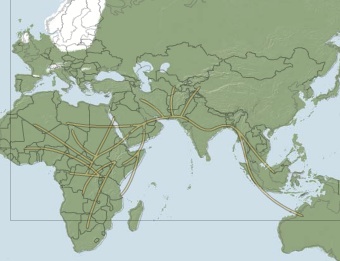
Somewhat after 79,000 years ago the Smith line began as part of M168 by moving north toward the Nile River

About 50,000 years ago the Smith line, as YAP, split off from most of M168 to go up the Nile River

The remaining not-Smith bulk of M168 went across the Red Sea to Arabia and as M89 and M9 went on to the Pamir Knot where they split into three groups that founded most of the populations of Europe, China, and India

Also about 50,000 years ago, M174 split off from the Smith line as cousins sharing the YAP-DNA. They followed the coast from the Red Sea to the Indian Ocean to the Pacific Ocean

and settled in Japan (branch P37.1) about 30,000 years ago

and in Tibet (branch M15) also about 30,000 years ago

About 40,000 to 30,000 years ago, the Smith part of YAP continued as M96 to go north along the Nile River

About 30,000 to 2-0,000 years ago, M2 split off from the Smith line as cousins sharing the M06-DNA.

Their southern branch may have combined with mt-DNA L0 population
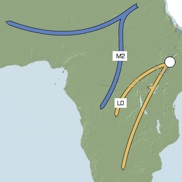
to form the Boskop population which had the largest brains in human history, but seems to have been extinct since about 10,000 years ago. As to what stress may have caused the extinction of the Boskop, as late as around 15,000 years ago, glaciation was still at a high level

but by about 10,000 years ago most of the glaciers had melted
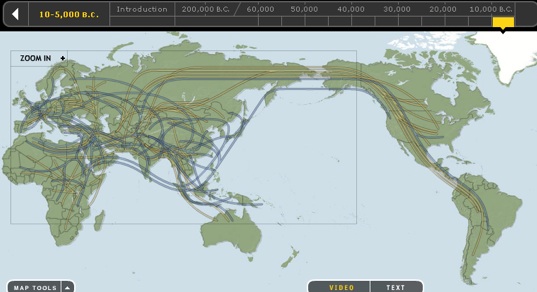
producing a much higher sea level that flooded much productive land. The loss of so much productive land led to conflict over limited resources, producing a strong evolutionary advantage for organized military with highest war technology, and a strong evolutionary disadvantage for contemplative high-level spirituality. From this time on, the large-brained Boskop were extinct and, acccording to a 23 March 2008 entry in john hawks weblog, "... there has been a reduction in the average brain size in South Africa during the last 10,000 years, and there have been parallel reductions in Europe and China -- pretty much everywhere we have decent samples of skeletons, it looks like brains have been shrinking ...".
Since (as anyone who has been through basic training knows) military discipline requires a high level of blind obedience and technical skill and also a low level of creative independent contemplative thought, it is not hard to understand why the Boskop might have been easy to kill off and why human brain size has been declining, especially in light of facts stated on the above-mentioned 23 March 2008 entry in john hawks weblog: "...
About 20,000 years ago, the Smith part of M96 continued as M35 to go north along the Nile River and the Mediterranean Sea

which is how the Smith line came to be in the Northern Adriatic part of the Roman Empire around 2,000 years ago and then

as Roman Legionnaires were stationed along the Danube Limes frontier fortifications, and then along the Rhine and on to Britain.
After the Smith line split off to go up the Nile River, the bulk of the M168 line and its successors (magenta) went on to populate the interior of Eurasia by going to Arabia, then to Eden and then to the Pamir Knot

from which three branches emerged which populated India, China, and most of Europe.
Comparison of the globe maps of the Smith line and the M168 Eden-Pamir line indicates that
The Romans perceived the world as shown on this Ravenna Cosmography map made by monks in Ravenna about 700 AD

on which I have colored the Smith line Nile (red), Danube (green), and Rhine (blue) Rivers, but since the Roman view of the world at that time did not include Japan, Tibet, or the Boskop I did not try to show the paths (yellow in the global map above) of the Smith line YAP or M96 cousins.
As to the Roman Legion part of the Smith line, my cousin Fred Smith, who shares my paternal Y-DNA, said "... the YHRD database that plots the frequency of Y-DNA results per population and geographically (actually maps it) ...[gives]... more specifics re our Y-DNA - as far as Italy is concerned, concentrated in north eastern Italy. As per our previous research, found along the Rhine near Cologne and Bonn, also the Roman settlements of Chester, London and the boundary between Wales and England, very much tracing the path that Caligula's and Claudius' armies took enroute to Britain and where stationed there. What was fascinating though is it's very high frequency in modern day Czech Republic, specifically in the region known as Vysocina, the center of which is the town of Telc ...".
It is interesting that our Y-DNA Roman Legion ancestors left descendants in Telc, but when you look at geography it makes sense. If our ancestors' Roman Legions were formed in North Eastern Italy then it would be an easier march to go around the Alps as shown on the following Google Earth images and that route would go pretty much directly to Telc
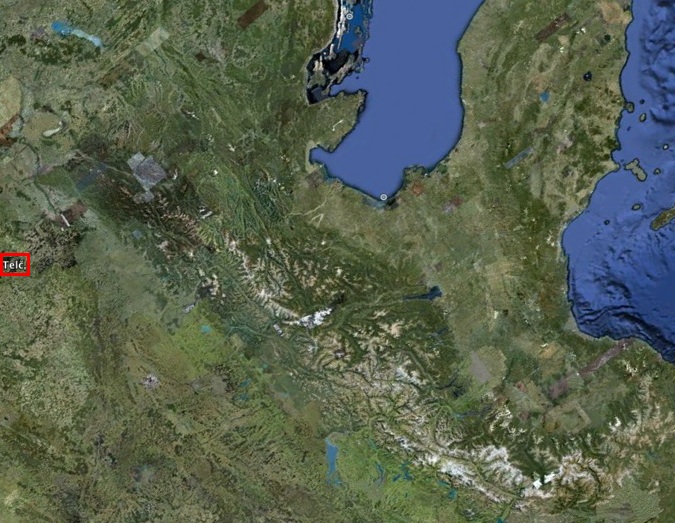
The route to Britain would then probably be directly from Telc through Germany via Sudetenland and Holland/Belgium/NorthernFrance to Britain
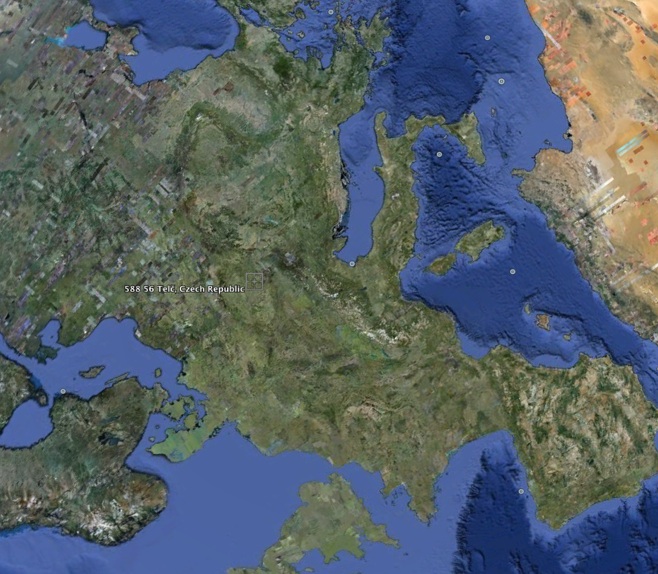
According to a www.livius.org/cg-cm/claudius_i/claudian_army_reforms.html web page:
"... Both Caligula and Claudius had ... plans to invade Britain ... it seems that Claudius created the limes along the Rhine and Danube ...".
The utility of the Rhine and Danube as fortified border regions of the Roman Empire is shown by this Heritage History map

You can see how our Y-DNA ancestors of North Eastern Italian Roman Legions went around the Alps to the Danube, and then up to the Danube headwaters North of the Alps to the headwaters of the Rhine and then down the Rhine to the sea near Britain, and then from there invading Britain.
As to the details of the invasion of Britain by Claudius in 43 AD, I have not found anything much better than wikipedia, which says in part:
"... The main invasion force under Aulus Plautius crossed in three divisions. The port of departure is usually taken to have been Boulogne, and the main landing at Rutupiae (Richborough, on the east coast of Kent). Neither of these locations is certain. Dio does not mention the port of departure, and although Suetonius says that the secondary force under Claudius sailed from Boulogne, it does not necessarily follow that the entire invasion force did. Richborough has a large natural harbour which would have been suitable, and archaeology shows Roman military occupation at about the right time. However, Dio says the Romans sailed east to west, and a journey from Boulogne to Richborough is south to north. ... An alternative explanation might be a sailing from the mouth of the Rhine to Richborough, which would be east to west. ...
Strabo (Geography 4:5.2) names the Rhine as a commonly-used point of departure for crossings to Britain in the 1st century AD. ...
Suetonius says that Claudius received the surrender of the Britons without battle or bloodshed. ... Cassius Dio relates that he brought war elephants and heavy armaments which would have overawed any remaining native resistance. ...".
According to a danube-limes.eu web page:
"... in the reign of Claudius (41-54 AD) ... the Romans ... came into power ... and the frontier was put forward to the Danube ... the army was stationed on the Danube limes by the end of the 1st century AD ... The evolved frontier existed nearly 400 years ... The last building campaigns date to the time of the Constantine dynasty (306-350) and the reign of Valentinan (364-375). ... After the death of Valentinan ... In 377 AD a united army of Goths, Alans and Huns invaded Pannonia ...(today Hungary ...)... in 433 AD the province was finally occupied by the Huns of Attila. ...".
According to Britannia.com web pages: "... AD ...
I would like to be able to connect the Smith line of the Roman Legions in Britain around 400 AD
to my paternal ancestor Benjamin Franklin Smith born in 1816 which line continues to the present day,
but
I have not found how to fill that 1,400 year gap.
My cousin Fred told me that Benjamin Franklin Smith's 1816 birthplace has been given by different sources as Virginia, South Carolina, and Georgia, and also that his wife, Mary Brewster Dickerson (1819-1895) may have lived in Rockingham County, Virginia, near Harrisonburg. Although some Smiths lived in that area around that time, including Abraham Smith and Daniel Smith whose residence is known as Smithlands, no records that I have seen show any relation to Benjamin Franklin Smith born in 1816.
Whether or not he is my ancestor, Abraham Smith may have led an interersting life. From various sources found by my cousin Fred, it seems that Abraham Smith was Sheriff of Rockingham County, had served in the Virginia Militia in the French and Indian Wars, had been captured by the French and spent some time in France, and may have been falsely accused of treason after his return to the USA.
Although there is a 1,400 year gap in my purely paternal Smith line, a mixed-gender line leading back from Mary Brewster Dickerson (1819-1895) can be traced back to 1170 AD, 23 generations back from my cousin Fred and me, as follows:
Mary Brewster Dickerson(1819-1895) (m. Benjamin Franklin Smith (1816-1893) Sarah Brewster (1781-1852) (m. James Dickerson (1775 - ) Mildred Downs (1760-) (m. James Brewster (1755-1804) Frances Chew (1730-1774) (m. Henry Downs, Jr. (1728-1798) Martha Taylor (1702-1762) (m. Thomas Chew (1700-1782)
Some Smith-Taylor line data including
"... 4. Taylor Line Ref: Mormon Church Ancestral File Records. ...
2. James Taylor II, born March 14, 1674, died June 23, 1729, lived in Caroline County, Virginia and King's and Queen's County, Virginia, married February 23, 1699, (1) Martha Thompson. The following children resulted from the first marriage:
came from homepages.rootsweb.ancestry.com/~pmcmcbride/james/f061.html#1771X2
James Taylor II (1674-1730)
James Taylor I (1635-1698) Chester UK to New Kent (Caroline) VA
John Taylor (1611-1658) Chester
Matthew Taylor (1555- -) Kent
Elizabeth Chute ( - ) (m. John Taylor (1530 - -) Kent Shadockhurst)
Margaret Culpeper (1499- ) (m. Philip Chute (1494-1567)
sister of Thomas Culpeper lover of Catherine Howard
Some Smith-Culpeper line data including


came from http://gen.culpepper.com/historical/howard/default.htm and http://gen.culpepper.com/ss/p8588.htm
Alexander Culpeper (1470 or 1454-1541) John Culpeper (1416-1480) Walter Culpeper (1382-1462) Thomas Culpeper (1345-1428) John Culpeper (1305-1370) Thomas Culpeper (1260-1321) Thomas Culpeper (1230-1309) John Culpeper (1200- ) Thomas Culpeper (1170 - )
So, by mixing gender, the 1,400 year gap is cut to about 800 years from 400 AD to 1200 AD.
Consideration of the history of Britain from 400 AD to 1100 AD indicates such turmoil that it might be hard to find records to fill in that gap in the Smith line. According to A time-line of Britain by Piero Scaruffi:
Frank D. (Tony) Smith, Jr. - 2010